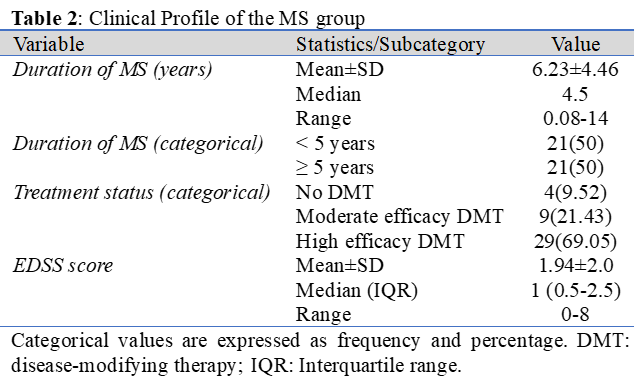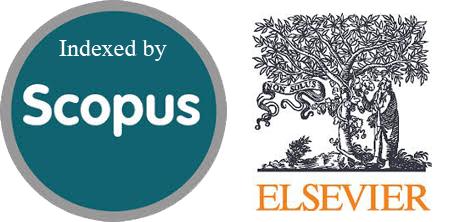Central and Peripheral Auditory Pathway Integrity in Multiple Sclerosis: A Case-Control Study Utilizing ABR and OAE
DOI:
https://doi.org/10.54133/ajms.v9i2.2324Keywords:
ABR, Auditory pathway, Autoimmune diseases, Demyelinating diseases, Multiple sclerosis, Otoacoustic emissionsAbstract
Background: Multiple Sclerosis (MS) is a demyelinating neurodegenerative autoimmune disease. Auditory brainstem response (ABR) testing can detect subtle disturbances in auditory signal transmission, localize retrocochlear pathway lesions, and evaluate treatment effectiveness in MS patients. Objective: Evaluate the function of central and peripheral auditory pathways in MS patients using ABR and OAE. Methods: A case-control study was conducted involving 42 MS patients and 42 matched healthy controls. All participants underwent full clinical and audiological evaluation, including pure tone audiometry (PTA), tympanometry, ABR, and OAE. Results: Symmetrically prolonged absolute latencies of Wave III, Wave V, and interpeak latencies (IPLs) were observed in MS patients compared to controls, with no significant effects of sex or disease duration. ABR abnormalities were more frequent in MS than in controls, while no significant differences were found between study groups regarding transient evoked and distortion product otoacoustic emissions (DPOAE). Conclusions: The central auditory pathway appears to be mainly affected in MS, evidenced by the prolonged absolute latencies and ILPs on ABR testing. Peripheral auditory pathway involvement is generally less common, though significant dysfunction at 8 kHz can indicate early cochlear involvement. These findings reflect the importance of comprehensive audiological evaluation in the diagnosis and monitoring of MS patients.
Downloads
References
Ahmed ZO, Dema HK, Yehia OT, Noel KI. Apparent diffusion coefficient in the diagnosis and follow-up of multiple sclerosis: Role of magnetic resonance imaging. Al-Rafidain J Med Sci. 2024;7:133–138. doi: 10.54133/ajms.v7i1.1114. DOI: https://doi.org/10.54133/ajms.v7i1.1114
Mohamed MM, Al-Ani MI, Al Gawwam G, Alrubaye MH, Al-Imam A. Detection of multiple sclerosis lesions in supra- and infra-tentorial anatomical regions by double inversion recovery, flair, and T2 MRI sequences: A comparative study in Iraqi patients. Al-Rafidain J Med Sci. 2023;5:S172-176. doi: 10.54133/ajms.v5i1S.357. DOI: https://doi.org/10.54133/ajms.v5i1S.357
Hammadi AMA, Marino A, Farhan S. Clinical outcome of 50 progressive multiple sclerosis patients treated with cellular therapy in Iraq. Int J Stem Cells. 2011;4:113–115. doi: 10.15283/ijsc.2011.4.2.113. DOI: https://doi.org/10.15283/ijsc.2011.4.2.113
Romero-Pinel L, Bau L, Matas E, León I, Muñoz-Vendrell A, Arroyo P, et al. The age at onset of relapsing-remitting multiple sclerosis has increased over the last five decades. Mult Scler Relat Disord. 2022;68:104103. doi: 10.1016/j.msard.2022.104103. DOI: https://doi.org/10.1016/j.msard.2022.104103
Leary S, Brownlee W, Barker N, Chard D, Chataway J, Chung K, et al, (Eds.), Multiple Sclerosis and Demyelinating Diseases. Neurology : A Queen Square Textbook, (3rd edn.), John Wiley & Sons, Ltd; 2024. p. 603–654. DOI: https://doi.org/10.1002/9781119715672.ch19
Ghasemi N, Razavi S, Nikzad E. Multiple sclerosis: Pathogenesis, symptoms, diagnoses and cell-based therapy. Cell J. 2017;19:1–10. doi: 10.22074/cellj.2016.4867.
Przewoźny T, Gójska-Grymajło A, Szmuda T, Markiet K. Auditory deficits in neurological disorders. Otolaryngologia Polska. 2015;69:11–20. doi: 10.5604/00306657.1170416. DOI: https://doi.org/10.5604/00306657.1170416
Lee S, Jeon ES, Cho HH. Auditory evoked potential inconsistency in sudden unilateral hearing loss with multiple sclerosis. J Int Adv Otol. 2019;15:160–164. doi: 10.5152/iao.2018.5225. DOI: https://doi.org/10.5152/iao.2018.5225
MacMahon H, El Refaie A. The audiovestibular manifestations as early symptoms of multiple sclerosis: a scoping review of the literature. Irish J Med Sci. 2022;191:391–400. doi: 10.1007/s11845-021-02508-3. DOI: https://doi.org/10.1007/s11845-021-02508-3
Travers BS, Tsang BK-T, Barton JL. Multiple sclerosis: Diagnosis, disease-modifying therapy and prognosis. Aust J Gen Pract. 2022;51:199–206. doi: 10.31128/AJGP-07-21-6103. DOI: https://doi.org/10.31128/AJGP-07-21-6103
McGinley MP, Goldschmidt CH, Rae-Grant AD. Diagnosis and treatment of multiple sclerosis. JAMA. 2021;325:765. doi: 10.1001/jama.2020.26858. DOI: https://doi.org/10.1001/jama.2020.26858
Brownlee WJ, Hardy TA, Fazekas F, Miller DH. Diagnosis of multiple sclerosis: progress and challenges. Lancet. 2017;389:1336–1346. doi: 10.1016/S0140-6736(16)30959-X. DOI: https://doi.org/10.1016/S0140-6736(16)30959-X
Uçar S, Sürmelioğlu Ö, Dana H. Comparative assessment of auditory and vestibular functions in multiple sclerosis patient using audiological diagnostic tools. Meandros Med Dent J. 2024;25:412–423. doi: 10.69601/meandrosmdj.1558551. DOI: https://doi.org/10.69601/meandrosmdj.1558551
Barbosa DAN, Silva LAF, Samelli AG, da Paz JA, Matas CG. Auditory central pathways in children and adolescents with multiple sclerosis. Arq Neuropsiquiatr. 2023;81:898–904. doi: 10.1055/s-0043-1775985. DOI: https://doi.org/10.1055/s-0043-1775985
Al-Dujaily MMS. The risk of hearing threshold estimation by click stimuli auditory brainstem response in children. Mustansiriya Med J. 2015;14:18–23. DOI: https://doi.org/10.4103/2070-1128.247823
Lachowska M, Prus-Ostaszewska M, Niemczyk K. Distortion-product otoacoustic emission phase shift test (Shift-DPOAE) – methodology of measurements and interpretation of results in example cases. Polski Przegląd Otorynolaryngologiczny. 2020;8:1–5. doi: 10.5604/01.3001.0013.7953. DOI: https://doi.org/10.5604/01.3001.0013.7953
Young A, Ng M. Otoacoustic Emissions. StatPearls [Internet]. StatPearls Publishing; 2025 [cited 2025 Jul 23]. Available from: https://www.ncbi.nlm.nih.gov/sites/books/NBK580483/.
Di Stadio A, De Luca P, Koohi N, Kaski D, Ralli M, Giesemann A, et al. Neuroinflammatory disorders of the brain and inner ear: a systematic review of auditory function in patients with migraine, multiple sclerosis, and neurodegeneration to support the idea of an innovative ‘window of discovery. Front Neurol. 2023;14. doi: 10.3389/fneur.2023.1204132. DOI: https://doi.org/10.3389/fneur.2023.1204132
AlSarhan H, Mohammed AA, T Yaseen E. Reliability of the otoscopic tympanic membrane findings in the diagnosis of middle ear effusion. J Pak Med Assoc. 2021;71(Suppl 8):S110–S112. PMID: 35130231.
Gür E, Binkhamis G, Kluk K. Effects of multiple sclerosis on the audio-vestibular system: a systematic review. BMJ Open. 2022;12:e060540. doi: 10.1136/bmjopen-2021-060540. DOI: https://doi.org/10.1136/bmjopen-2021-060540
Lanvers‐Kaminsky C, Zehnhoff‐Dinnesen AM, Parfitt R, Ciarimboli G. Drug‐induced ototoxicity: Mechanisms, pharmacogenetics, and protective strategies. Clin Pharmacol Ther. 2017;101:491–500. doi: 10.1002/cpt.603. DOI: https://doi.org/10.1002/cpt.603
Kerneis S, Caillaud E, Bakhos D. Auditory brainstem response: Key parameters for good-quality recording. Eur Ann Otorhinolaryngol Head Neck Dis. 2023;140:181–185. doi: 10.1016/j.anorl.2023.04.003. DOI: https://doi.org/10.1016/j.anorl.2023.04.003
Kramer S, Brown DK, (Eds.), Audiology: Science to Practice, (4th edn.), Audiology: Science to Practice, Fourth Edition. Plural Publishing, Inc.; 2021.
Filippi M, Preziosa P, Banwell BL, Barkhof F, Ciccarelli O, De Stefano N, et al. Assessment of lesions on magnetic resonance imaging in multiple sclerosis: practical guidelines. Brain. 2019;142:1858–1875. doi: 10.1093/brain/awz144. DOI: https://doi.org/10.1093/brain/awz144
Delphi M, Sayaf M, Taheri F, Majdinasab N. Audio and vestibular analyses in patient with multiple sclerosis. Hearing Balance Commun. 2021;19:270–275. doi: 10.1080/21695717.2021.1933318. DOI: https://doi.org/10.1080/21695717.2021.1933318
Matas CG, Matas SL de A, de Oliveira CRS, Gonçalves IC. Auditory evoked potentials and multiple sclerosis. Arq Neuropsiquiatr. 2010;68. doi: 10.1590/S0004-282X2010000400010. DOI: https://doi.org/10.1590/S0004-282X2010000400010
Rishiq D, Harkrider A, Springer C, Hedrick M. Click-evoked and speech-evoked auditory brainstem responses from individuals with multiple sclerosis. Neurosci Lett. 2021;740:135460. doi: 10.1016/j.neulet.2020.135460. DOI: https://doi.org/10.1016/j.neulet.2020.135460
Saberi A, Hatamian HR, Nemati S, Banan R. Hearing statement in multiple sclerosis: a case control study using auditory brainstem responses and otoacoustic emissions. Acta Med Iran. 2012;50:679–683. PMID: 23275283.
Pokryszko-Dragan A, Bilinska M, Gruszka E, Kusinska E, Podemski R. Assessment of visual and auditory evoked potentials in multiple sclerosis patients with and without fatigue. Neurol Sci. 2015;36. doi: 10.1007/s10072-014-1953-8. DOI: https://doi.org/10.1007/s10072-014-1953-8
Kaytanci E, Ilkay Ozdamar O, Acar GO, Tekin M. Evaluation of transiently evoked otoacoustic emissions and auditory brainstem responses in patients with multiple sclerosis. Ear Nose Throat J. 2016;95.
Srinivasan VS, Krishna R, Munirathinam BR. Effectiveness of brainstem auditory evoked potentials scoring in evaluating brainstem dysfunction and disability among individuals with multiple sclerosis. Am J Audiol. 2021;30:255–265. doi: 10.1044/2020_AJA-20-00155. DOI: https://doi.org/10.1044/2020_AJA-20-00155
Ivanković A, Nesek Mađarić V, Starčević K, Krbot Skorić M, Gabelić T, Adamec I, et al. Auditory evoked potentials and vestibular evoked myogenic potentials in evaluation of brainstem lesions in multiple sclerosis. J Neurol Sci. 2013;328:24–27. doi: 10.1016/j.jns.2013.02.005. DOI: https://doi.org/10.1016/j.jns.2013.02.005
Sanfins MD, Colella-Santos MF, Ferrazoli N, Rezende A, Donadon C, Gos E, et al. Latency and interpeak interval values of auditory brainstem response in 73 individuals with normal hearing. Med Sci Monitor. 2022;28. doi: 10.12659/MSM.937847. DOI: https://doi.org/10.12659/MSM.937847
Lima TMA, Crato AN, Mancini PC, Simões LC, Gonçalves DU. Alterations in early auditory evoked potentials in multiple sclerosis patients. Braz J Otorhinolaryngol. 2009;75. doi: 10.1016/S1808-8694(15)30775-8. DOI: https://doi.org/10.1016/S1808-8694(15)30775-8
Ko KF. The role of evoked potential and MR imaging in assessing multiple sclerosis: A comparative study. Singapore Med J. 2010;51.
Zantaoui A, Zakaria Y, Lakhdar Y, Chehbouni M, Oulghoul O, Benhoummad O, et al. Screening for cochleovestibular disorders in multiple sclerosis : A Study of 100 patients. Int J Innov Res Med Sci. 2025;10:173–178. doi: 10.23958/ijirms/vol10-i05/2069. DOI: https://doi.org/10.23958/ijirms/vol10-i05/2069
Peyvandi A, Naghibzadeh B, Roozbahany NA. Neuro-otologic manifestations of multiple sclerosis. Arch Iran Med. 2010;13.
Di Stadio A, Dipietro L, Ralli M, Meneghello F, Minni A, Greco A, et al. Sudden hearing loss as an early detector of multiple sclerosis: a systematic review. Eur Rev Med Pharmacol Sci. 2018;22:4611–4624. doi: 10.26355/eurrev_201807_15520.
Nguyen TH, Vaussy A, Le Gaudu V, Aboab J, Espinoza S, Curajos I, et al. The brainstem in multiple sclerosis: MR identification of tracts and nuclei damage. Insights Imag. 2021;12:151. doi: 10.1186/s13244-021-01101-7. DOI: https://doi.org/10.1186/s13244-021-01101-7
Collongues N, Becker G, Jolivel V, Ayme-Dietrich E, de Seze J, Binamé F, et al. A Narrative review on axonal neuroprotection in multiple sclerosis. Neurol Ther. 2022;11:981–1042. doi: 10.1007/s40120-022-00363-7. DOI: https://doi.org/10.1007/s40120-022-00363-7
Leocani L, Bianco M, Di Maggio G, Medaglini S, Gonzalez-Rosa J, Chieffo R, et al. Evoked potentials may predict response to immunomodulating treatment in multiple sclerosis (S39.003). Neurology. 2013;80. doi: 10.1212/WNL.80.7_supplement.S39.003. DOI: https://doi.org/10.1212/WNL.80.7_supplement.S39.003
Di Mauro R, Di Girolamo S, Ralli M, de Vincentiis M, Mercuri N, Albanese M. Subclinical cochlear dysfunction in newly diagnosed relapsing-remitting multiple sclerosis. Mult Scler Relat Disord. 2019;33:55–60. doi: 10.1016/j.msard.2019.05.020. DOI: https://doi.org/10.1016/j.msard.2019.05.020

Downloads
Published
How to Cite
Issue
Section
License
Copyright (c) 2025 Al-Rafidain Journal of Medical Sciences ( ISSN 2789-3219 )

This work is licensed under a Creative Commons Attribution-NonCommercial-ShareAlike 4.0 International License.
Published by Al-Rafidain University College. This is an open access journal issued under the CC BY-NC-SA 4.0 license (https://creativecommons.org/licenses/by-nc-sa/4.0/).











